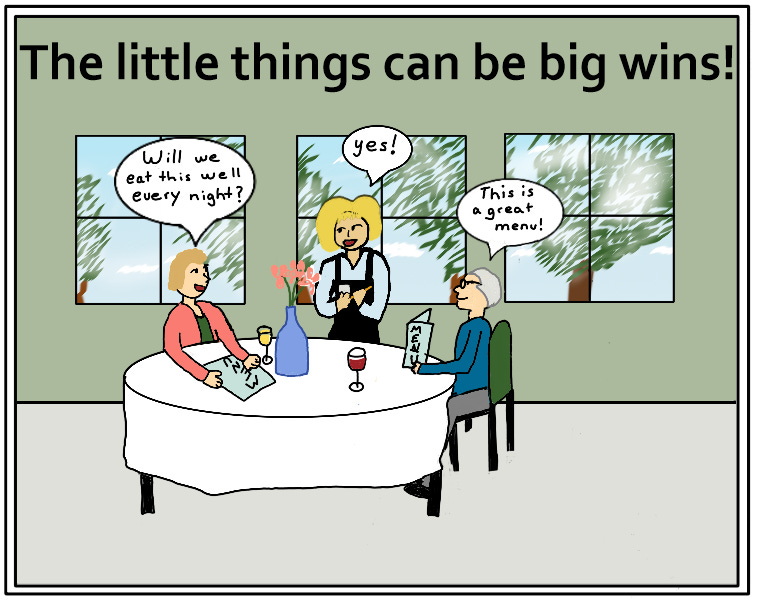About our Guests
Michelle (AKA Shelly) de la Calle is Director of System Integration at County of Santa Clara Health System. You can find Michelle on LinkedIn.
Sue Lueder is one of the podcasters and founders of the Hindsight Retros Project, and Michelle’s sister. She can be found on LinkedIn.
Jack Lueder is the father of Sue and Michelle and a retired aerospace engineer from Lockheed Martin.
Main Takeaways from this Episode
Instead of complex open-ended questions, ask specific, finite questions. E.g. instead of “Which of your possessions are important to you?” a question like “What are the top three things in this room that are most important to keep?” Open-ended questions are harder to answer, whereas specific and finite questions are easy and approachable and can give you enough data points that you can start to guess how they would answer questions you might discover later.
Ask for help from your support system. Many of us default to struggling with frustration silently, but our friends and family may be happy to hear you vent and/or discuss solutions. And pay it back – when you’re in a place of stability, pay it back, be the support others need.
It could be valuable to have a pre-action briefing, assigning tasks, setting up a safe word, overcommunicating about expectations – before activity has started, and while everybody’s calm.
The move into assisted living is not always a fun one, but it’s easier to talk about before an emergency makes it an absolute necessity. It will be a smoother transition if the elders are relatively healthy physically and mentally during the move, and most facilities have a sliding scale of assistance. Here are some tips:
When you broach the subject, make sure it’s during a relaxed time and everyone is alert and ready to discuss.
Give them a heads up that you want to have the talk and try not to surprise them.
When discussing the reasons for the move, focus on their wellbeing and safety, and emphasize the positive aspects of these facilities, such as less work for them, more social interaction, and oftentimes better amenities such as meals and environment.
If your parents have friends or family members who have already moved, have your parents talk to them to get their impressions and (hopefully) sing the praises of their new situation.
Talk about the reasons to move proactively, before assistance becomes a critical need – that is, before parents lose more of their faculties or health.
When setting up the new place, be thoughtful about what makes a living place a “home.” How do you make a new space feel like your own? It’s going to be different for everyone, but with the right questions and introspection you can prepare a new space to be your home with less risk of transfer trauma. Here are some ideas:
Think about the important spaces within a home, like a place to read mail, an armchair to read books, or a comfy couch to watch Netflix. Involve your parents in identifying and recreating these homey spaces. Even better if you can set them up before the move date so that they’re ready straight away.
Clutter can be a big problem for anyone in a new home, but for parents who may be more prone to overwhelm it can be even worse. Think about creating a spot to capture those miscellaneous items that don't have a storage location and help your parents get them organized.
Many parents may be attached to personal rituals like cooking, gardening, or laundry – things that might be handled by the assisted living facility. Sue and Shelly’s parents liked to cook, and make coffee. If space permits, it can be comforting to bring the gear for those activities, even if it’s not technically necessary, to help relieve the feeling of losing control or freedom.
Review the decor in the original home, and identify new spots in the new place and don't delay in getting these into place. Digital photo frames can be a great housewarming gift.
Find family photos to post around the home. If one or more of your parents are dealing with memory issues, they may have trouble associating the new location with the word “home;” Sue and Shelly had luck using the term “new home” to help bridge this gap. The reminder that a change is occurring may help the person with memory issues feel less disoriented.
It can be valuable to do research to figure out a reasonable timeframe for a project – e.g. you can search how long it takes to pack up and move out of a house of a certain size.
Best Practice Links
Assisted Living Move Checklist
What is Transfer Trauma and How to Avoid It
Product Links
For getting rid of stuff:
Contact
Follow us at hindsightretros.substack.com
Follow Sue Lueder on LinkedIn
Follow John Reese on LinkedIn


















Share this post